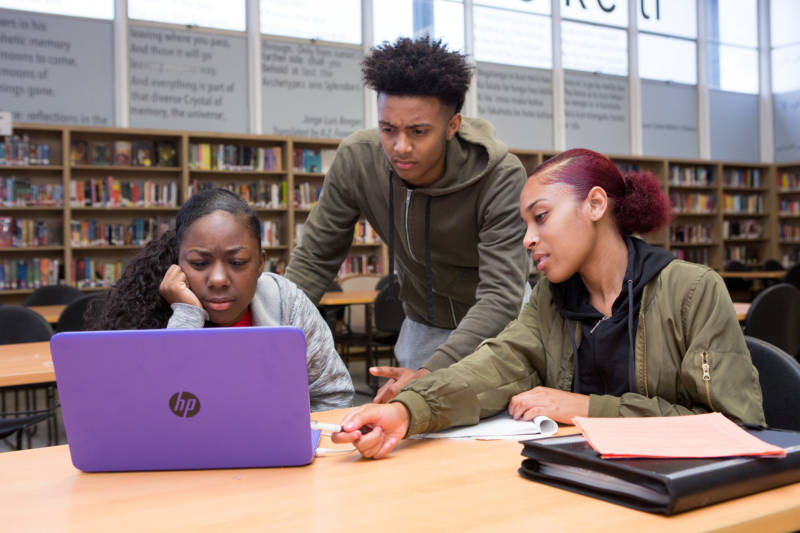“I think that the lessons of history are exactly the kind of thing we should be talking about in history class,” Wineburg said. “But rather than teaching them as rules or things fixed in time or set in amber, these are precisely the kinds of things that are worthy of debate.”
Today, most people look up information they don’t know on the internet, including students. So it’s even more important that students have tools they can use to make educated decisions about what they trust online.
IN THE CLASSROOM
Will Colglazier, a U.S. history teacher in the San Mateo Union High School District, is taking this call to action to heart at Aragon High School. He, like so many teachers, feels pressure to cover all his content and keep to the pacing guides, but he also thinks students need fundamental digital literacy skills in order to continue learning history into the future.
“Less is more and you have to cut content in order to make room to bring in the skills that you deem essential,” Colglazier said. “This isn’t the only time they could access information. It’s not like their ability to learn US history ends in May.”
Colglazier balances the curriculum coverage pressure with cross-cutting skills by thinking carefully about his course goals. He establishes those at the beginning of the year so that if he ends up cutting a unit to make time for something else, he can be sure he’s still hitting those goals. Especially in his Advanced Placement classes he feels pressure to get through all the material, to make sure his students get high scores, and thus succeed. But at some point he decided enough was enough.
“I kept getting frustrated teaching the course and having my unit tests aligned with what the AP test is like,” Colglazier said. That led to boring assessments and a boring class. Instead, he decided to mix in more historical inquiry into his classes, with plenty of practice on the AP-style test questions as well.
He started asking more controversial, open-ended questions and asked students to find information to support their claims about those topics. He wanted students asking questions and engaging in the activities of real historians, so he pushed students to engage their critical thinking skills, put issues into context, and gave them opportunities to close read for perspectives and silences. He thought those historical skills would transfer to the digital space -- but he was wrong.
“The hypothesis that it would just transfer for all is not true,” Colglazier said. “It must be explicitly taught.”
His students didn’t do well on the Stanford test to determine ads versus news stories. But they were doing a lot of online research in class already, so Colglazier decided to spend some time explicitly teaching students how to fact-check websites, to read laterally, and go beyond slick-looking web design.
“They don’t like to be duped,” Colglazier said of his students. “That’s an intrinsic desire of anyone. You don’t want to look like an idiot. They want support and they’re pretty willing to accept it. Some of it is not rocket science, it’s just about explicitly teaching it.”
Now, Colglazier regularly replaces multiple-choice or short-answer questions with activities that require students to mimic the experience of online research. He’ll ask a broad question and send them to an article that may not be from a reliable site. Students have to figure out if they can trust the information and, if not, find more reliable sources to back up their claims.
Colglazier doesn’t think these types of activities stray too far from his curriculum. Whereas before he might have distributed several documents he’d found and ask students to work at their desks to use the documents to back up a claim, now he’s sending them online. And he’s not curating the resources for them. He expects students to have a better reason to trust a source than “the teacher gave it to me.”
“One thing I have found is that it’s messy,” Colglazier said. “And it’s certainly less efficient than if I just told them the information. But it’s about the skill development and cutting content to provide that space where the messiness occurs.”
Colglazier is also trying to be clearer with students about how these skills apply to both history and life. Often students get nihilistic at first, thinking that every time they visit a website they’ll have to go down a research rabbit hole. That may be the price of living in a world with so much information at their fingertips; they have to ask questions about their sources. The textbook itself is ripe for interrogation in Colglazier’s class. Textbook can be a useful course skeleton, he says, but he wants students to question its silences and framing as well.
“When students read the textbook, they mine it for facts without thinking meta about it,” he said. “And we want to teach them to do that with all their information. You’re protecting them from learning to some degree” if you don’t.
LONGER TERM SOLUTIONS
Sam Wineburg at Stanford doesn’t blame teachers for not immediately knowing how to teach these crucial digital media skills, but he hopes studies like his will prompt changes. In the short term he wants everyone -- adults and kids alike -- to learn to use the internet like fact-checkers do. On top of that, he’d like to see social studies teaching shift away from covering every unit in a huge textbook, and toward critical inquiry about history. Beyond all that, he thinks we need a dramatic change in how we consume information.
In a Twitter thread capturing these ideas Wineburg writes, “Of course, in our Civics classes we need new approaches. But if we think this issue is only about Civics, we’re deluding ourselves. This is about how we teach EVERY subject.”


